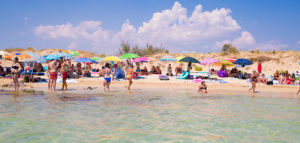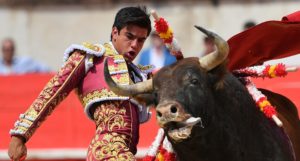Few of the many holidaymakers photographing their artisanal breakfast for a sunlit post on Instagram will have heard of Albert Smith. But they owe him a moment’s reflection: for if anyone can be said to have perfected the packaged visuals of a holiday abroad, it is Smith, a showbusiness titan of mid-Victorian London. Smith’s wildly popular panoramic spectaculars of his travels across Europe drew audiences of thousands. He was a prolific journalist, a bestselling novelist, a man-about-town, a mountaineer, and a dandy, but it was Smith’s innovative talent for boiling down his adventures abroad into a collection of vivid and memorable images that proved his biggest crowd-puller. Panoramas — vast paintings showing a 360-degree view of a landscape — had been part of the London scene since the turn of the century, but Smith took the panoramic experience to new levels of immersion: he was the self-appointed star of his own show, dramatising his own adventures against a sliding background of tableaux complete with music and props.
Smith’s most celebrated panorama relived his ascent of Mont Blanc in 1851 — which had been an astonishing physical feat for a clubbable bon viveur (though he had to be dragged to the summit barely conscious, he claimed to have celebrated by drinking a bottle of champagne and smoking a cigar). He pulled out all the stops to recreate Mont Blanc on the stage of the Egyptian Hall, Piccadilly in 1852, importing woodcarvers from Chamonix to recreate a Swiss chalet. St Bernards roamed the aisles and during the interval hot baked potatoes were dispensed for those in the audience feeling a glacial chill from the buckets of cold water placed around the hall. The stage was decked with alpine plants; there was a waterfall with real water, a mill wheel and a lily pond; the walls of the theatre were hung with chamois skins. “The Ascent of Mont Blanc” ran for six years and 2,000 performances, and on top of the fortune he made in ticket sales, Smith cannily expanded his repertoire by selling colouring books, fans, board games and miniature models of Mont Blanc.
Smith, an unrepentant populist (he liked to shock Thackeray by saying that Shakespeare was “all rot”), knocked the high culture out of the touristic experience. He made the adventure of foreign parts bite-sized and accessible — if not in reality, at least in dreams. He called it “the Alps in a box”. Figuratively speaking, Smith’s panoramas boxed up the great sights of the classical Grand Tour and sold them in miniature form, building them up with a dramatic flourish then cutting them down to size with a knowing dig in the ribs. Smith’s success runs parallel with the emergence of photography, the industrial manufacture of souvenirs, and the “I was here” frame of the postcard. After Smith, it became possible to think of “buying” the travel experience without actually going very far, framing it, and taking it home with you. Antiquarian high-culturists looked for quiddity and oddity when abroad but Smith encouraged a joyful appetite for mass-produced kitsch. His own apartment off Tottenham Court was a riot of knick-knackery from his travels. There was a figure of a Swiss peasant with a clock-face in his waistcoat, Venetian glasses, miniature Swiss chalets, soap from Vienna in the shape of fruit and a working model of a guillotine.
The tourist boom in Chamonix inspired by Smith was viewed with horror by those who thought the mountain were theirs to command. Ruskin found the “white leprosy of hotels” and souvenir shops that followed the visitors into the Alps was a blasphemy against “all the deep and sacred sensations of nature”. Everywhere the new tourists went, reported a journalist in 1856, they brought with them “Cockneyism, Albert Smithery, fun, frolic and vulgarity”. The rise in popular tourism to Europe, sparked most importantly by Thomas Cook, had highlighted a divide which has characterised British travelling ever since. In this paradigm, the tourist is the new bug and the traveller is the old soul. And even when they are gazing at the same view, the latter thinks the former is spoiling the view. The distaste is notable in how often crowds of tourists were, and still are, described in terms of mindless cattle or insects — they come in “herds” and “swarms” and “flocks”.
Naturally as most people like to think they are an old soul, the tourist, as Evelyn Waugh put it, “is the other fellow”. Wherever the crowd goes, it is sure to be perceived by those in another crowd to debase the special spirit of place. Quite what the original spirit of place is often hard to define, but traditionally the British tourist thinks that their fellow countrymen are trampling on it. Newlywed Emily Birchall in 1870 found her visit to St Peter’s ruined by the sight of a British tourist reading his guidebook under the high altar and one feels her pain. The more expensive and bespoke the tourist experience, the more it will sell itself as being particular and unconventional, off the beaten track, away from the throng; until the throng reaches Easter Island or Lapland or Everest. Which of course it almost always does.
Thomas Cook, progenitor of the modern package tour, was a much more serious character than Smith, a former printer and temperance campaigner whose package tour business started as an effort to keep working men away from the pub on the holidays (more properly known as holy days) that constituted their only days off. By the time Smith had conquered Mont Blanc, Cook had been running tours to the Continent for several years. He had become used to the jibes about “Cooks’ Tourists” with their aspirational itineraries and their guidebooks, with points of interest rated by stars or exclamation marks. But Cook was proud of his groups and of what he was introducing to people unaccustomed to travel. “Practical people from the provinces and representatives of the better style of the London mercantile community” is how he described his tourists and he loved them. And they loved him too — a Thomas Cook tour became a byword for trustworthiness and paternal consideration. What Cook offered was something new: the holiday as a collective as well as an individual experience. And it brought with it all the expansions and limitations of the group itself.
From Lawrence Sterne’s fastidiously risk-averse Dr Smelfungus to a coach tour of larky cockneys in Carry on Abroad, the humour that can be squeezed out of the comical figure of the Brit abroad still seems inexhaustible. One of Albert Smith’s many insights was that tourists like laughing at their fellow countrymen. The ingénue, the know-nothing, the stuck-up type, the travel bore, the vulgarian and the gullible lady traveller all make appearances. They were a satirical speciality of comic novelists like Thomas Moore (The Fudge Family in Paris) and Thackeray (The Kickleburys on the Rhine). The one defining feature is that the reader does not recognise herself in these hopeless embarrassments: they are other ones, the noisy passengers in the overcrowded night train or the ones (snigger) demanding a cup of tea in bad French. Those for whom maintaining social distinctions was important have found plenty to criticise in their fellow tourists but increasingly, others were delighted by the general flattening of class signifiers. By the Thirties, a passenger on a cruise noted: “The thing about cruising is that everyone is dressed in the same kind of light and bright clothing, and so you cannot tell the dukes from the dustmen.”
In the end most people, it appears to me, are after the same thing. British tourists of all types are surely at heart seeking a slice of pastoral, however mass-produced it might be in reality. It doesn’t seem to matter how inauthentic the peasant culture or the artisanal breakfast may be, for tourism simultaneously kills and preserves the thing it seeks. Even the hermetically-sealed world of the beach resort offers its own version of a lost arcadia. So what if the price of arcadia is other people?
Disclaimer
Some of the posts we share are controversial and we do not necessarily agree with them in the whole extend. Sometimes we agree with the content or part of it but we do not agree with the narration or language. Nevertheless we find them somehow interesting, valuable and/or informative or we share them, because we strongly believe in freedom of speech, free press and journalism. We strongly encourage you to have a critical approach to all the content, do your own research and analysis to build your own opinion.
We would be glad to have your feedback.
Source: UnHerd Read the original article here: https://unherd.com/



